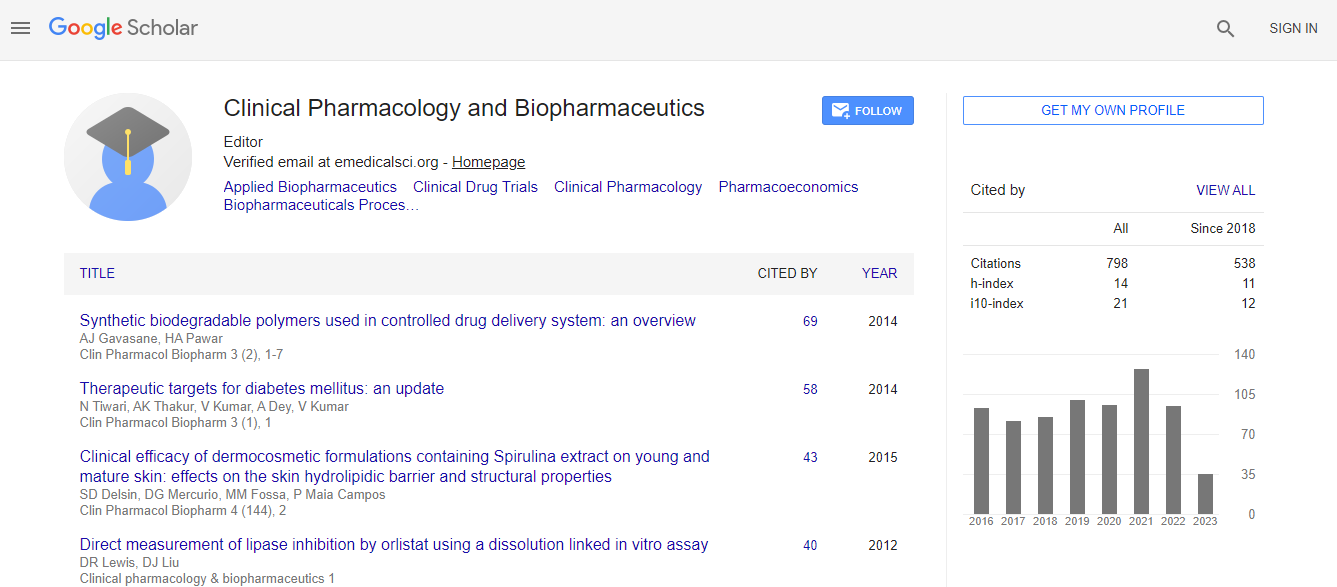Our Group organises 3000+ Global Conferenceseries Events every year across USA, Europe & Asia with support from 1000 more scientific Societies and Publishes 700+ Open Access Journals which contains over 50000 eminent personalities, reputed scientists as editorial board members.
Open Access Journals gaining more Readers and Citations
700 Journals and 15,000,000 Readers Each Journal is getting 25,000+ Readers
Google Scholar citation report
Citations : 1089
Clinical Pharmacology & Biopharmaceutics received 1089 citations as per Google Scholar report
Clinical Pharmacology & Biopharmaceutics peer review process verified at publons
Indexed In
- CAS Source Index (CASSI)
- Index Copernicus
- Google Scholar
- Sherpa Romeo
- Genamics JournalSeek
- RefSeek
- Hamdard University
- EBSCO A-Z
- OCLC- WorldCat
- Publons
- Euro Pub
- ICMJE
Useful Links
Recommended Journals
Related Subjects
Share This Page
Ozone Prevents Cochlea Damage from Ischem├?┬▒a/Reperfus├?┬▒on Injury In Gu├?┬▒nea P├?┬▒gs
International Conference and Expo on Biopharmaceutics
Merih Onal, Cagdas Elsurer, Nebil Selimoglu, Mustafa Yilmaz, Ender Erdogan, Jale Bengi Celik and Ozkan Onal
Meram Educational and Training Hospital Department of Otolaryngology, Turkey Selcuk University Medical Faculty Department of Otolaryngology, Turkey Meram Educational and Training Hospital Department of Plastic Surgery, Turkey Selcuk University Med
Posters-Accepted Abstracts: Clin Pharmacol Biopharm
Abstract
Introduction: The cochlea is a metabolically endorgan dependent on nutrient and oxygen supply to maintain its normal physiological function. It is very sensitive to alterations in blood circulation that transient ischemia of the cochlea may result in common otologic disorders. Cochlear ischemia and reperfusion injury has been considered one of the most important causes of human idiopathic sudden sensorineural hearing loss. Ozone is a method in which a gas combination containing ozone and oxygen has been used as a therapeutic agent for the treatment of many diseases. Ozone treatment creates resistance against oxidative stress by inducing antioxidant systems. This research has been conducted to study the efficacy of ozone therapy against cochlear damage because of ischemia and reperfusion, to investigate the potential clinical use of this treatment for sudden deafness. We evaluated cochlear histology and the biochemical parameters characterizing the oxidative stress under ozone treatment. Material and Method: 28 guinea pigs were randomized into four groups. Control group (n:7) was administered SF intraperitoneally seven days without creating ischemia reperfusion injury and at eight day the guinea pigs were sacrified. Ozone group (n:7) was administered 1 mg/kg ozone intraperitoneally for seven days without creating ischemia reperfusion. 1 mg/kg ozone was administered intraperitoneally for seven days before IR injury in Ischemia Reperfusion (IR)+ Ozone group (I/R+O) (n:7) and at eighth day, these guinea pigs were subjected to cochlear ischemia for 15 minutes by occluding left vertebral artery with a nontraumatic clamp and then reperfusion for two hours. Ischemia Reperfusion (IR) group were subjected to cochlear ischemia for 15 minutes by occluding left vertebral artery without ozone therapy. After the ischemia/reperfusion procedure, guinea pigs were sacrified at the same day. For general histological evaluation, cochlear and spiral ganglionic tissues were examined with a light microscope and apoptotic cells were counted with TUNEL (Terminal deoxynucleotidyl transferase dUTP nick end labeling) staining and apoptotic index (AI) was calculated. Blood samples were sent for superoxide dismutase (SOD), glutation peroxidase (GSH-Px), catalase(CAT), malondyaldehide (MDA), total oxidant score (TOS) and total antioxidant capacity (TAC) analysis. Data were evaluated statistically by Kruskal Wallis test. Results: In ischemia-reperfusion group, the degree of apoptotic index was found highest and statistically significantly compared to the other groups (p<0.05). In the group ischemia reperfusion+ozone (IR+O), apoptotic index was found to be lower in comparison to ischemia reperfusion (IR) group (p<0.05). Antioxidant parameters like SOD, GPX, TAC values were found to be increased in ozone group and lowest in IR group (p<0.05). MDA and TOS oxidant parameters were found to be highest in IR group and decreased in ozone group (p<0.05) . Discussion: Controlled ozone administration was able to stimulate the endogenous antioxidant defense systems and could prepare the host to face ischemia reperfusion injury. Ozone oxidative preconditioning may prevent ischemic tissue reperfusion injury. In the present study, we found a statistically significant decrease in cochlear ischemia reperfusion damage with ozone therapy. Further studies will be necessary to explain the protective mechanisms of ozone therapy on cochlear IR injury.Biography
Email: drozkanonal@selcuk.edu.tr

 Spanish
Spanish  Chinese
Chinese  Russian
Russian  German
German  French
French  Japanese
Japanese  Portuguese
Portuguese  Hindi
Hindi 
